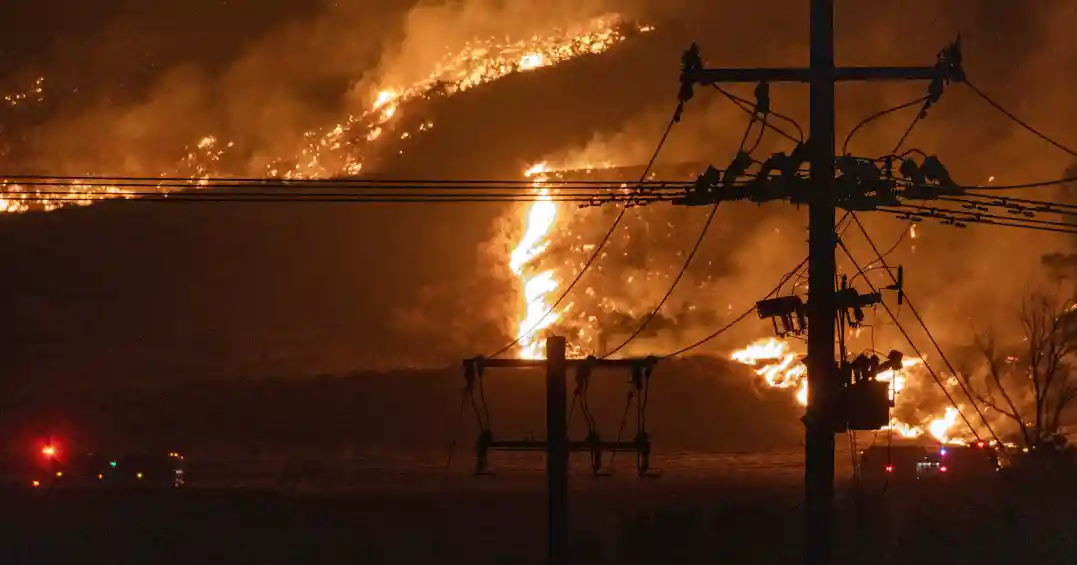 The Hughes Fire, in Castaic, Calif., has burned more than 10,000 acres.Amy Katz/ZUMA
The Hughes Fire, in Castaic, Calif., has burned more than 10,000 acres.Amy Katz/ZUMA
Fight disinformation: Sign up for the free Mother Jones Daily newsletter and follow the news that matters.
It’s been two weeks since the outbreak of the devastating Los Angeles wildfires that have burned more than 40,000 acres and killed at least 28 people.
While significant progress has been made in containing the Palisades and Eaton fires, the two most destructive wildfires to ever hit LA—72 and 95 percent contained, respectively, compared to 17 and 35 percent a week ago, with far less damage since—there has been little time to celebrate the win. On January 22, two other fires around Los Angeles took off, bringing the total burned acreage above 50,000.
Firefighters were quick to action on the Sepulveda Fire off Interstate 405 near the Bel-Air neighborhood. “We were able to keep it only to 40 acres,” Los Angeles Fire Department spokesperson David Ortiz told CNN. “The Santa Ana winds are blowing against this fire, so we had that in our favor.” The fire is now 60 percent contained.
But north of LA, near the city of Santa Clarita, the Hughes Fire burned 10,000 acres in less than 24 hours, expanding 50 times in size—from 100 to 5,000 acres—and putting more than 30,000 people under mandatory evacuation orders. It’s still just 24 percent contained, although county firefighters have managed to keep any structures from burning down. Sheila Kelliher, a spokesperson for the Los Angeles County Fire Department, compared that effort to the Palisades Fire, where wind gusts were up to 80 t0 100 miles per hour—which she called “like fighting a hurricane with a fire attached to it.”
Notably, a Los Angeles County jail, the Castaic complex, was within the evacuated area. While 476 incarcerated people were moved from the south facility to the north facility, 4,700 remained sheltered in place overnight in a mandatory evacuation zone. Los Angeles County Sheriff Robert Luna said the choice was made in consultation with the fire department.
The ACLU of Southern California put out a statement urging the evacuation of those in the complex, saying it had “long opposed the expansion of the jail system especially in dangerous fire zones,” and was “gravely concerned for the safety of people incarcerated in those jails.”
Melissa Camacho, of ACLU of Southern California, called the move highly unorthodox. “I certainly haven’t heard of a general plan,” she said, “either in LA County or anywhere else, that involves sheltering in place when there’s a mandatory evacuation.”
The only exception Camacho could think of was Pepperdine University, near Malibu, which has a long-standing shelter-in-place plan pre-reviewed by the fire department.
“Perhaps it was that they wouldn’t have been able to evacuate them in time and that that was the only reason it was safer to shelter in place,” Camacho said. The LA Times reports that a shortage of transport buses—a long-standing problem for the Los Angeles Sheriff’s Department—contributed to the logistical troubles.
“I’m not willing to lose one person at that facility,” Luna told the LA Times on January 22, saying extra support was given to protect it. The night passed without damage or fatalities, but Camacho emphasized that “if people had died, there is a whole host of laws that would have been broken” by choosing not to evacuate them.
Camacho said the family members she spoke to were “in the dark” about the safety of their loved ones at Castaic. “It’s something we’re going to see happen more and more, and it’s really not something that we as a society should accept.”
Meanwhile, more than a thousand of California’s incarcerated firefighters have been on the ground trying to contain the wildfires as they sweep through the area.
The Los Angeles branch of the National Weather Service has warned that better does not mean safe: “This is a DANGEROUS fire day TODAY,” it posted on social media Thursday. “Winds will continue to increase and expand this morning. Humidity is already extremely dry…Much of LA & Ventura Counties are at critical Red Flag levels. Any new fire can grow rapidly.”
No cause has been directly identified for any of the recent fires, but experts cite climate change as a key contributor. Research from the University of California, Los Angeles, found that human-caused climate change may be linked to about a fourth of “the extreme fuel moisture deficit when the fires began.” The dry fuels contributed to the intensity of the fire.
“When it’s that dry, wind has ultimate power,” UC Merced climatology professor John Abatzoglou told CalMatters.
“The fires would still have been extreme without climate change, but probably somewhat smaller and less intense,” the researchers wrote.
Meanwhile, President Trump has signed a flurry of executive orders targeting climate action—including one attempting to undo water regulations in California meant to save an endangered fish—and has also threatened to withhold FEMA funding from California.
